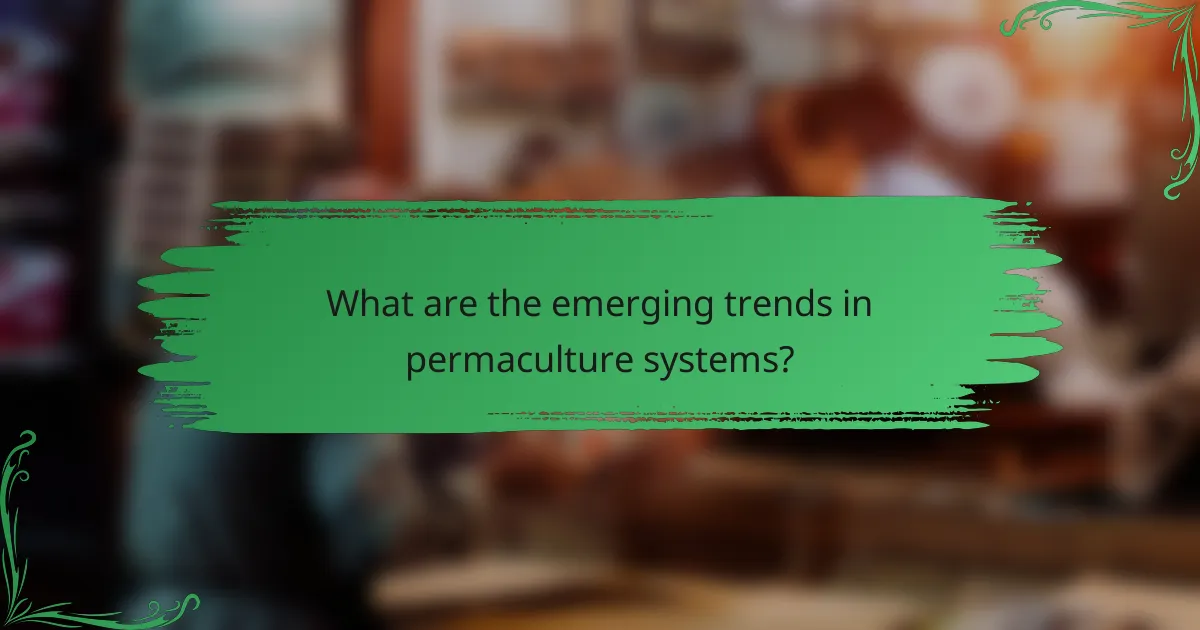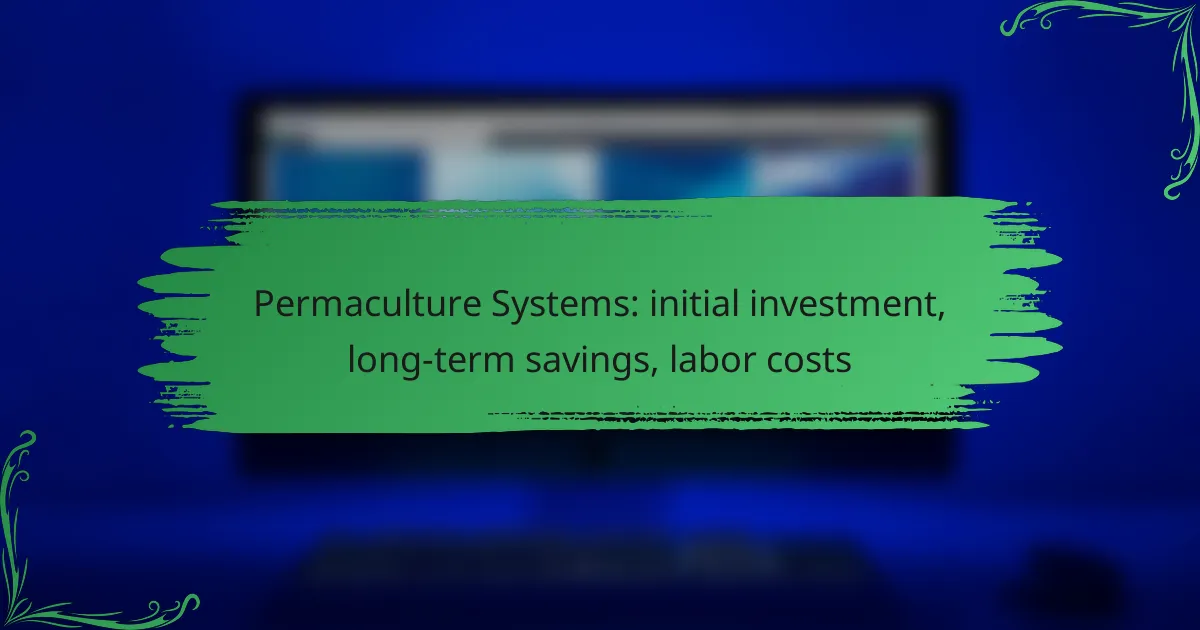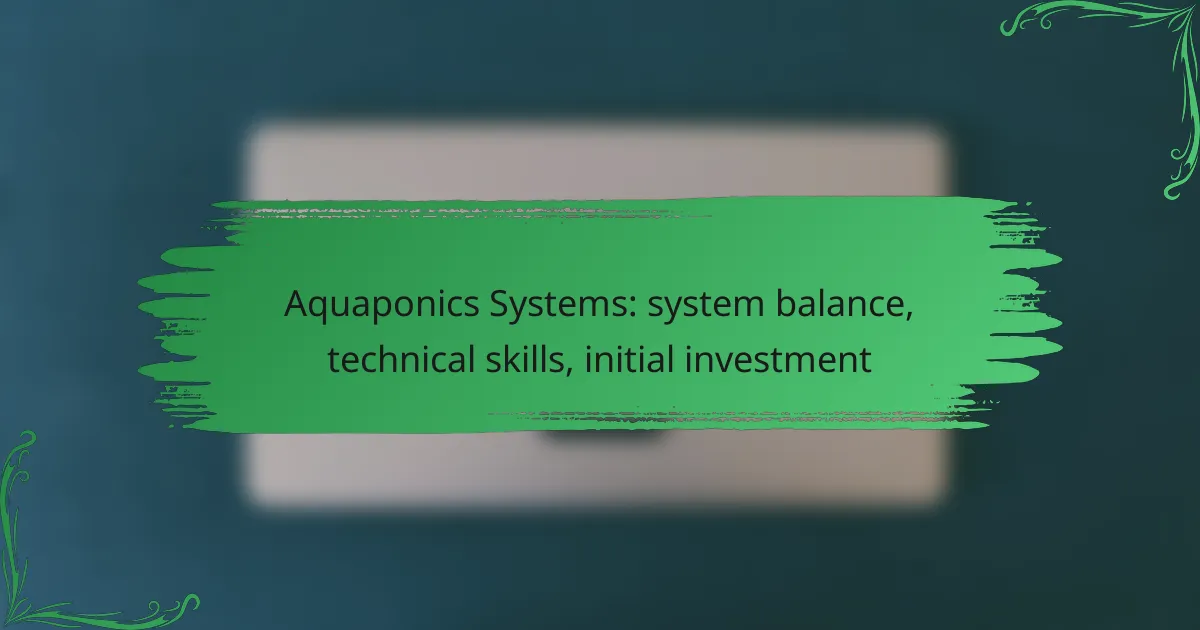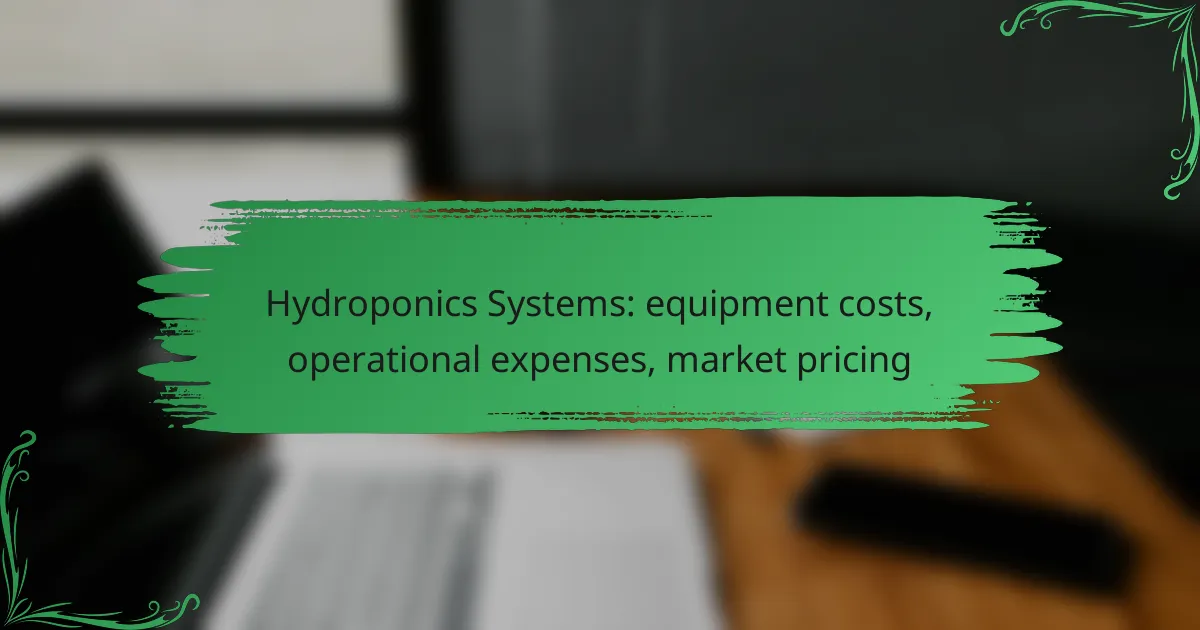Permaculture systems require an initial investment that can range from a few thousand to tens of thousands of dollars, influenced by factors such as land size and design complexity. However, these systems offer long-term savings by optimizing resource use and minimizing waste, leading to reduced ongoing expenses for water and maintenance. While initial labor costs may be higher during setup, ongoing maintenance can become less intensive, making permaculture an economically viable option over time.

What is the initial investment for permaculture systems?
The initial investment for permaculture systems can vary significantly based on factors like land size, location, and design complexity. Generally, costs can range from a few thousand to tens of thousands of dollars, depending on the specific elements involved in establishing the system.
Typical costs for land preparation
Land preparation is a crucial first step in establishing a permaculture system. Costs can include soil testing, clearing, and amending the land, which may range from a few hundred to several thousand dollars. For example, hiring professionals for soil amendments can cost around $500 to $2,000, depending on the size of the area and the amendments needed.
Expenses for planting and materials
Expenses for planting and materials encompass seeds, seedlings, and other necessary components like mulch or compost. On average, initial planting costs can range from $200 to $1,500, depending on the diversity of plants chosen and the size of the garden. It’s often beneficial to prioritize native species, as they typically require less maintenance and are more resilient.
Investment in tools and equipment
Investing in tools and equipment is essential for maintaining a permaculture system. Basic tools like shovels, rakes, and hoes can cost between $100 and $500, while more advanced equipment like tillers or irrigation systems may push costs to $1,000 or more. Consider starting with essential tools and gradually expanding your collection as needed.
Permaculture design consultation fees
Hiring a permaculture design consultant can enhance the effectiveness of your system, though it adds to the initial investment. Consultation fees typically range from $50 to $150 per hour, with total costs varying based on the complexity of the design. Investing in professional guidance can lead to better long-term outcomes and savings.
Cost variations in urban vs. rural settings
Cost variations between urban and rural settings can be significant. Urban areas often have higher land prices and may require additional expenses for permits or zoning compliance, leading to initial investments in the low tens of thousands. In contrast, rural settings typically offer more affordable land options, allowing for a more budget-friendly setup, often in the range of a few thousand dollars.

How do permaculture systems lead to long-term savings?
Permaculture systems can significantly reduce costs over time by optimizing resource use and minimizing waste. By creating a self-sustaining ecosystem, these systems lower ongoing expenses related to water, maintenance, and inputs while potentially increasing revenue through surplus produce sales.
Reduction in water usage
Permaculture designs often incorporate techniques such as rainwater harvesting and swales, which help to maximize water retention in the landscape. This can lead to a reduction in water bills, especially in regions where water is a costly resource. For instance, implementing these methods can cut water usage by up to 50% compared to traditional farming practices.
Additionally, using drought-resistant plants and mulching can further decrease the need for irrigation, allowing for more efficient water management. This not only saves money but also promotes sustainability in water-scarce areas.
Lower maintenance costs over time
As permaculture systems mature, they typically require less labor and fewer inputs, leading to lower maintenance costs. The use of perennial plants and companion planting can create a balanced ecosystem that naturally controls pests and diseases, reducing the need for chemical interventions.
Over time, the initial investment in establishing a permaculture system pays off as the need for manual labor decreases. Many practitioners report that after the first few years, their systems become self-sustaining, allowing them to focus on other projects or income-generating activities.
Increased crop yield efficiency
Permaculture systems are designed to maximize land use and improve soil health, resulting in higher crop yields per area. Techniques such as crop rotation, intercropping, and using cover crops can enhance soil fertility and productivity, often leading to yields that exceed those of conventional farming methods.
By optimizing plant placement and diversity, permaculture can create a more resilient agricultural system that produces food more efficiently. This means that even small plots of land can yield substantial harvests, contributing to overall savings and food security.
Potential for selling surplus produce
One of the financial benefits of permaculture is the potential to sell surplus produce. As systems become more productive, growers can harvest more than their household needs, creating opportunities for income generation. Selling excess fruits, vegetables, or herbs at local markets can provide a significant financial return.
Additionally, community-supported agriculture (CSA) models can be established, where local consumers subscribe to receive regular shares of produce. This not only helps cover costs but also fosters community engagement and support for sustainable practices.

What are the labor costs associated with permaculture systems?
Labor costs in permaculture systems can vary significantly based on the scale of the project and the chosen methods. Initial setup often requires more labor, while ongoing maintenance can be less intensive, depending on the design and management practices.
Initial setup labor requirements
The initial setup of a permaculture system typically involves substantial labor for tasks such as site preparation, planting, and infrastructure installation. This can range from a few weeks to several months, depending on the complexity of the design and the size of the area being developed.
Common tasks include soil amendment, planting trees and shrubs, building raised beds, and installing irrigation systems. Engaging in these activities may require a team of volunteers or hired help, which can influence overall labor costs significantly.
Ongoing maintenance labor needs
Once established, the ongoing maintenance of a permaculture system generally requires less labor compared to the initial setup. Regular tasks include weeding, harvesting, and monitoring plant health, which can often be managed by a few hours each week.
The labor intensity can vary based on the design’s efficiency and the local climate. For example, a well-planned system may require minimal intervention, while a less efficient setup might demand more frequent attention.
Comparison of DIY vs. hiring professionals
Choosing between a DIY approach and hiring professionals for permaculture installation can significantly impact labor costs. DIY projects can save money but may require a steep learning curve and more time investment.
On the other hand, hiring professionals can streamline the process and ensure that best practices are followed, but this option typically incurs higher upfront costs. Weighing the long-term benefits against initial expenditures is crucial in making an informed decision.

What are the prerequisites for starting a permaculture system?
Starting a permaculture system requires understanding the local environment, assessing soil health, and identifying available resources. These prerequisites ensure that the system is sustainable and tailored to the specific conditions of the site.
Understanding local climate conditions
Climate conditions significantly influence the success of a permaculture system. Factors such as temperature, rainfall, and seasonal variations dictate what plants will thrive and how water management should be approached.
To assess local climate, consider using historical weather data and local agricultural reports. This information helps in selecting appropriate crops and designing effective water catchment systems.
Assessing soil health and quality
Healthy soil is the foundation of a successful permaculture system. Conducting a soil test can reveal pH levels, nutrient content, and organic matter, which are crucial for plant growth.
Improving soil health may involve adding compost, mulching, or using cover crops. Aim for a balanced mix of nutrients to support diverse plant life and enhance soil structure.
Identifying available resources and materials
Identifying local resources is essential for building a cost-effective permaculture system. This includes assessing what materials are readily available, such as wood for structures, water sources, and native plants.
Consider creating a list of local suppliers or community resources, such as seed exchanges or composting programs. Utilizing local materials reduces costs and supports sustainability.

How to choose the right permaculture design for your location?
Selecting the appropriate permaculture design for your location involves assessing local climate, soil conditions, and available resources. Understanding these factors will help you create a sustainable system that thrives in your specific environment.
Factors to consider in urban environments
In urban settings, space is often limited, so vertical gardening and container planting are effective strategies. Consider utilizing rooftops and balconies to maximize growing areas while adhering to local zoning laws.
Soil quality can vary significantly in cities; testing for contaminants is essential. Urban permaculture may also benefit from community gardens, which can provide shared resources and knowledge among neighbors.
Design strategies for suburban areas
Suburban areas typically offer more land than urban settings, allowing for diverse permaculture designs like food forests and edible landscaping. Incorporating native plants can enhance biodiversity and reduce maintenance costs.
Water management is crucial; consider rainwater harvesting systems to utilize natural resources efficiently. Additionally, check local regulations regarding water use and landscaping to ensure compliance.
Rural permaculture design options
In rural environments, there is often greater flexibility in design choices, including larger-scale systems like agroforestry and rotational grazing. These methods can improve soil health and increase crop yields over time.
Consider the availability of resources such as water and sunlight, as well as the potential for integrating livestock into your design. Implementing permaculture principles can lead to significant long-term savings on inputs and labor costs.

What are the emerging trends in permaculture systems?
Emerging trends in permaculture systems focus on sustainable practices that enhance biodiversity, improve soil health, and optimize resource use. These trends reflect a growing awareness of environmental issues and a shift towards regenerative agriculture that benefits both ecosystems and communities.
Initial investment
The initial investment in permaculture systems can vary widely depending on the scale and complexity of the design. Small-scale home gardens may require a few hundred dollars for materials and plants, while larger projects could demand several thousand dollars for infrastructure and land preparation.
Key factors influencing the initial costs include soil amendments, water management systems, and planting diverse species. It’s crucial to plan carefully and consider long-term benefits, as these investments often lead to reduced costs over time.
Long-term savings
Long-term savings from permaculture systems can be significant, primarily through reduced reliance on external inputs like fertilizers and pesticides. By fostering a self-sustaining ecosystem, permaculture can lower ongoing expenses related to maintenance and resource acquisition.
For example, a well-designed permaculture garden can yield food for many years, decreasing grocery bills. Additionally, water conservation techniques can lead to lower utility costs, especially in regions where water is scarce.
Labor costs
Labor costs in permaculture systems can be lower than traditional farming methods due to the emphasis on natural processes and minimal intervention. Once established, these systems often require less ongoing labor for maintenance, as they are designed to be self-sustaining.
However, initial setup may demand considerable effort to establish the ecosystem, including planting, soil preparation, and creating water management systems. It’s essential to balance the upfront labor with the long-term benefits of reduced maintenance and increased resilience.



